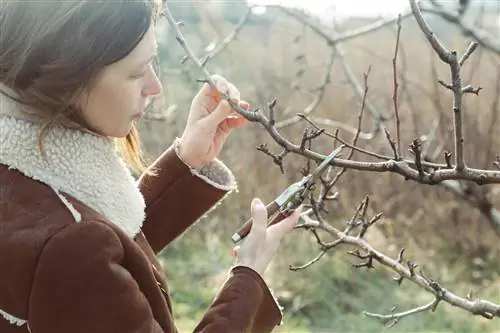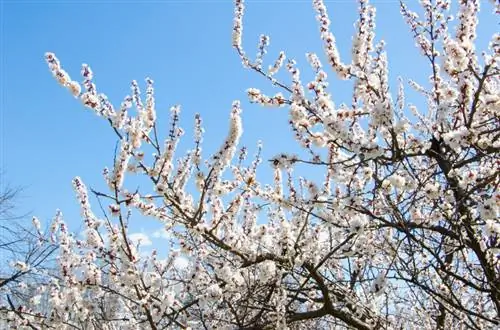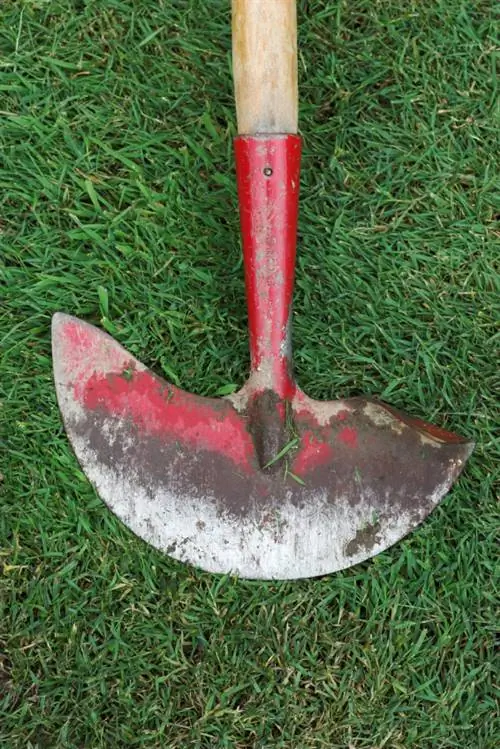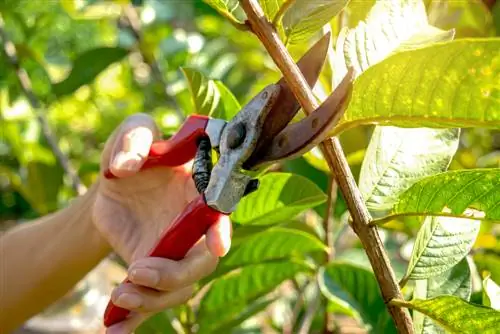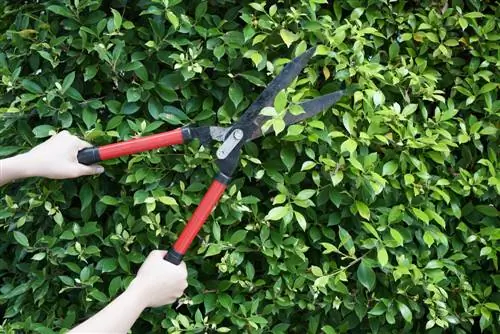- Author admin [email protected].
- Public 2023-12-24 06:09.
- Last modified 2025-06-01 06:02.
In Mother Nature's kingdom, trees can grow freely because they have an almost unlimited amount of space available. Garden trees, on the other hand, are assigned special functions that they have to fulfill in a limited area. For this reason, gardeners choose special cultivars that bloom magnificently, have a decorative spherical crown, produce a rich harvest of juicy fruits or impress with other attributes. This tutorial invites you to explore the species-appropriate pruning care of deciduous trees, conifers and fruit trees.

Should you cut trees?
Prune deciduous trees in late winter for the first 5-10 years. Through regular shape and alignment cuts you can achieve controlled height and length growth. Target the tips of the leading branches if they are very branched.
Deciduous trees benefit from proper pruning at any age - an overview
Deciduous trees are the ace up the gardener's sleeve when the garden design requires a representative eye-catcher. From majestic wild species to small cultivated varieties, there is the ideal house tree for every garden size. If pruning care begins at a young age and continues regularly, trees remain as easy to care for as they get older and are break-proof. The following table lists the most important types of cutting with information on the desired cutting goal and the best dates:
| Types of cutting deciduous trees | Goal/Occasion | best date |
|---|---|---|
| Build-up cut | Education of the ideal growth habit with densely leafy crown | in the first 5 to 10 years in late winter |
| Conservation cut | Maintain crown shape, control size growth, promote vitality and flowering ability | Late winter from January to early March |
| Rejuvenation cut | revitalize old deciduous tree | November to February |
With the exception of a few early-flowering ornamental trees and fruit trees, summer has no longer served as the central pruning time for trees. Scientific studies and field tests lasting several years have proven that trees and hedges cope better with pruning in late winter. Light maintenance cuts should take place around St. John's Day (June 24th). At this time, most plant species take a short break in growth.
Building and training young deciduous trees - this is how it works
A deciduous tree in top form presents itself with a slender, straight trunk and a harmoniously shaped, densely leafed crown. The crown itself is made up of ascaffolding system4 to 6leading branchesare arranged around a tightly uprightcentre shoot, where side branches form. This structure remains throughout life and should be raised carefully. As the figure below shows, pruning care in the first few years aims to build the perfect tree crown. How to do it right:
- The best time is in late winter, in good time before budding
- Middle shoot with 5 to 7 scaffold shoots during the construction phasedo not cut back
- Instead, slim down theshoot tips by removing unnecessary side shoots
- Cut off steeply upward competing shoots to the crown structure at the base
If any cheeky shoots sprout from the trunk below the crown, remove these too. The same applies to steep wild shoots from the root area. If trees are grafted onto a wild base,water shootscan form, which compete with the noble crown for nutrients. By pulling out wild shoots, you remove the last remaining tissue from which they could grow again.
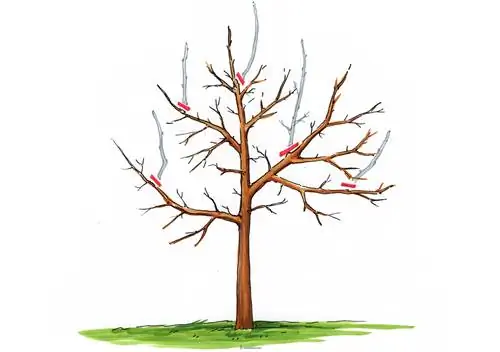
Do not cut back the central shoot and leading branches while the crown is being built. Instead, slim down the shoot tips without removing the tip buds. Thin out shoots that are steeply directed upwards and compete with the scaffold branches.
Background
Knowing the growth law and top funding provides security when trimming trees
When pruning, the top buds of the crown center shoot and leading branches are not cut for good reasonOne of three fundamental laws of growth states that trees grow strongest from their top buds. This applies equally to the trunk, central shoot and every branch or twig. Because the tips reach sunlight most quickly, plants pump their juices powerfully upwards. On deeper buds, the sap pressure reduces the greater the distance to the respective tip bud. When building the crown, only cut off top buds when all types of shoots have reached the desired length.
Shape and thinning pruning keeps deciduous trees vital and well-formed
Well-behaved trees are spared from scissors and saws in the first few years. Regular inspections point out any necessary pruning measures in a timely manner, such as cutting back shoots that are too long or removing dead wood. The aim of the shape and thinning cut is a beautifully shaped, light-flooded crown with a dense foliage as well as the control of length and height growth. The illustration below shows the example of the chestnut tree before and after comparison of an expert pruning procedure. This is how your trees stay vital and beautiful:
- Thoroughly thin out the treetops in late winter every 4 to 6 years
- Saw off dead branches on Astring
- Remove shoots that compete with the leading branches and all inward-facing branches
- Do not leave hook-shaped stubs
- Branches that are too long or protrude from the shape of the crown should be transferred to a side shoot that is lower down
- Cut or tear off wild shoots from the trunk and tree disc
There is not always a side shoot to direct the branch that is too long onto it. Shorten the shoot to the desired length with acut on buds With this cutting technique, you don't cut just anywhere, but specifically. Place the pruning shears a few millimeters above an outward-facing bud or pair of buds. In this way, you can already point the fresh shoots in the right direction of growth.
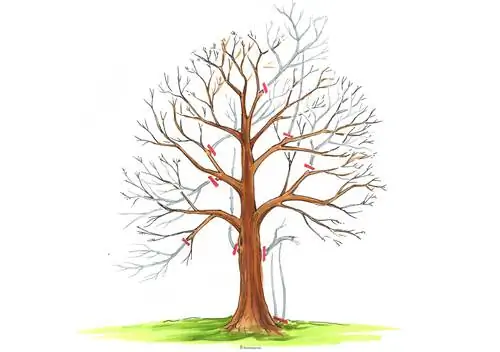
Many trees are only trimmed and thinned every 4 to 6 years. Branches that are too long lead you to a younger side shoot. Cut off dead, weak branches that point towards the inside of the crown on Astring. Shoots sprouting below the crown or from the tree disc are removed.
Shrink trees that are too large, don’t just cut them down
The growth of native trees is often underestimated. Within a few years, the growth rockets will exceed the existing space capacity. Copping trees that have fallen into disrepair is taboo The radical measure destroys the natural habitus and leaves behind large wounds that no longer close. Ultimately, rot spreads and the entire tree becomes unstable.
To reduce the size of a deciduous tree, we recommendmoderatethinning and topiary pruning. In late winter, remove dead wood and all branches that are not part of the crown structure. Any remaining shoots that are too long can be transferred to a side shoot that is further back. Strongly branched tips of the leading branches are slimmed down. If you repeat the recommended pruning careevery 3 to 5 years, your tree will become noticeably smaller and still retain its natural shape.
Tip
Popular ball trees thrive without a dominant central shoot. A classic example is the maple cultivar globe maple 'Globosum'. To ensure that the round crown shape is preserved, these trees should be trimmed and thinned every 2 to 3 years in late autumn. Thin out dead wood and shorten the remaining branches by a third.
Revitalize old deciduous trees - this is how rejuvenation pruning works
If pruning care is neglected over many years, deciduous trees become bare and senescent, turning into unsightly bushes. Rejuvenation pruning can correct the problem on various deciduous and fruit trees. Since the scope of the cut goes far beyond the normal maintenance cut, rejuvenation should only be carried outin exceptional cases. Please ask your trusted tree nursery in advance whether your tree is suitable for the following revitalization. How to do it professionally:
- The best time is during the leaf-free period from November to the end of February
- Previously thin out dead branches on Astring
- Do the same with weak, poorly positioned and inwardly growing shoots
- Remaining leading branches are diverted by a third or half to a younger side shoot
- Shorten old leading branches to 10 to 20 centimeter long cones
The illustration below uses the example of an old pear tree to demonstrate how rejuvenation is successful. Ultimately, what remains is a basic structure consisting of a central shoot, leading branches with a few side shoots. The more old branches you can connect to young shoots, the more successful the revitalization will be. Where drainage is not possible, cut the branch back to a 10 to 20 centimeter peg. This dries back a bit over time. After a while, fresh shoots sprout from the base and the dried tissue is removed.

An old pear tree is one of the deciduous trees that can handle radical rejuvenation pruning. Shorten all leading branches by half. Use Astring to thin out dead wood, weak and awkwardly positioned branches. Strong growth sets in, which is controlled by regular shape and maintenance pruning.
Background
Federal Nature Conservation Act has the final say on cutting times
As you read this tutorial, you will have noticed that more extensive pruning is limited to the winter time. If you heed the recommendation, you will follow the requirements of the Federal Nature Conservation Act. According to paragraph 39, trees may generally be trimmed from October 1st to February 28th. This applies to thinning, putting on the stick and other in-depth cutting measures. The reason is to protect wild animals that raise their offspring during the summer. Primarily native bird species prefer to nest in treetops, hedges and bushes. Therefore, during the summer grace period, light pruning of all types of trees is permitted to a limited extent, provided no animals are affected.
Pruning conifers rarely - instructions for pruning care
When cutting conifers, horticultural reservations are certainly appropriate. In fact, most conifers are noticeably more sensitive to cutting than deciduous trees. If trees have needles instead of leaves, they will no longer sprout from old wood. The main reason is the avoidance of creating sleeping eyes along the shoots as an “iron reserve” in the event that active parts of the plant fail. To cut pine, cypress or fir trees, the following premises must be observed:
- Always prune coniferous trees ingreen, needled areas
- Never shorten or remove scaffolding shoots in the unneeded area
- Throttle growth with light pruning in June (St. John's Day)
- Drop branches that are too long onto a shorter, densely needled side branch
Conifers respond to a radicalrejuvenation cutwith atotal failure. The only exception are yew trees, which will forgive you a cut into the old wood and a rejuvenation cut if necessary.

If shoots on conifers are too long, redirect them to a shorter side branch. If two shoots are opposite each other, like on a Christmas tree, slim down the new tip to a single, well-needled shoot.
Pruning fruit trees is not a closed book - the 5 best tips
Expert pruning care for fruit trees goes beyond pruning ornamental deciduous trees. To ensure that the trees not only form abeautiful crown, but also provide arich fruit harvest, important premises must be taken into account. The following 5 tips will familiarize you with the basics of fruit tree pruning:
Cutting fruit trees in winter
The time of cutting has a significant influence on growth. The earlier in the winter you cut a fruit tree, the more vigorously it will sprout in the spring. Since weaker growth is conducive to flower and fruit formation, vigorous apple and pear trees should be pruned in late winter. Aim for strong growth on young fruit trees, prune as early as October or November.
Tighten dense crowns in good time
Dead wood is poison for a vital fruit tree. Dead branches shade the valuable fruit wood, which reduces the number of flowers and fruits. Therefore, thin out the crowns of your trees regularly. An old gardening rule is that you can throw a hat through a cut fruit tree and it will fall to the ground. Of course, the old rule should not be taken quite so literally. Follow the rule of thumb: the airier the crown, the larger and juicier the fruit.
note juice scale
The classic fruit tree crown is shaped like a pyramid. A continuous central shoot carries three to four leading branches. In order for the crown to develop evenly, it is important to maintain the sap balance. The tip buds of the leading branches must be at the same level so that they grow evenly. At the same time, their distance from the tip bud of the main stem must not be too great. Cut a fruit tree so that the center shoot tip protrudes over the leading branches by around 20 centimeters, as shown in the illustration below.
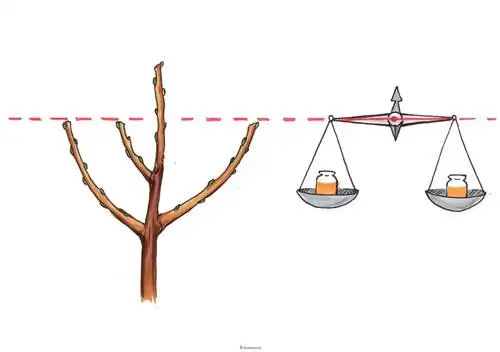
The tip buds of the leading branches must be at the same height. If the crown of the fruit tree is in the sap scale, it bears fruit faster.
Steep branches do not bear fruit
The laws of growth teach us that a steeply upward shoot does not think about creating buds for a flower. Instead, leaves sprout constantly, which are important for the formation of reserve substances. Only when the shoot moves in an inclined to horizontal direction of growth do flowers and fruits form. Do not simply cut off steep branches on fruit trees. Tie down the shoots or hang small weights from them to direct growth into a flatter position. The first flowers and fruits won't be long in coming.
Rejuvenate fruit wood regularly
Popular fruit trees, such as apple and pear, bear the juiciest fruit on biennial flowering branches. Over time, the shoots age and hang to the ground. To encourage trees to produce young fruiting wood, divert old wood onto a slanting or horizontal shoot. Cut off any removed fruit wood where a young shoot decorated with flower buds branches off.
Tree pruning basics - basics of pruning technique
Common cutting techniques have already been discussed in this tutorial. The following overview explains important cuts in more detail in a practical and beginner-friendly way:
Derivation cut
It plays a key role in construction and maintenance cutting. You will prune your trees correctly at any age if you are familiar with derivation pruning. The main advantage is that you don't simply cut off branches that are too long or in an unfavorable position, but rather redirect them to a conveniently positioned, young side shoot. As illustrated below, cut exactly where the old and young branches fork.
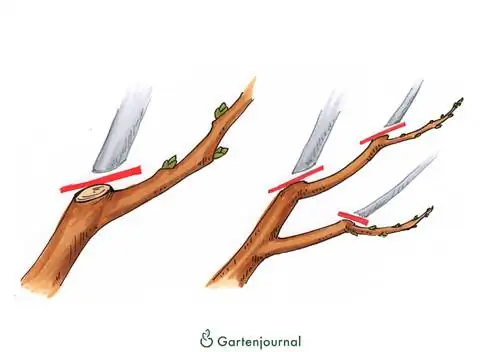
The species-specific crown shape of your trees is maintained if you divert branches that are too long or unfavorable to a younger side shoot below.
Cut to Astring
Older trees sometimes make it necessary to thin out dead leading branches. To ensure that deciduous trees survive the procedure unscathed, the branch ring must not be injured. A branch ring can be recognized as a small or thick bulge at the transition from branch to trunk. There is valuable tissue in it that is later responsible for wound healing. Please position the saw so that you can cut downwards and outwards at ashort distance from the branch. The image below illustrates the right and wrong procedure.

If you shorten a shoot, make the cut 3 to 5 millimeters above an outward-facing bud. Do not cut into a bud or leave a stub longer than 1 centimeter.
Cut thick branches in stages
If branches are more than arm-thick or particularly heavy, there is a risk of breakage when cutting in one go. The result is serious damage to the tree. The danger is averted if you cut thick branchesin stages. As the illustration below shows, this is the correct way to proceed:
- Start at a distance of 40 to 50 centimeters from the actual interface
- Place the saw on the underside and cut to the middle
- Support the branch with your free hand at a safe distance from the saw blade
- Make the next cut with the saw 10 to 20 centimeters away on the top of the branch
- Sawing until the branch breaks through
The last stage is dedicated to the remaining stump. Saw this off on Astring. Finally, smooth the cut with a knife.
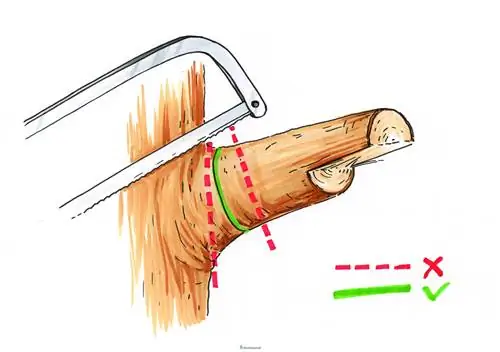
Thick branches are removed gradually and on astring. First, saw the branch from below 40 to 50 centimeters away from the actual cutting point. Move the saw slightly to cut from above until the branch breaks. Saw off the remaining stump on Astring.
The right tool for tree pruning - tips on scissors and saw
Prune thin branches of your trees with pruning shears, either as bypass shears or anvil shears. You can easily cut thicker branches with a diameter of 2 to 3 centimeters with two-handed pruning shears. If you choose a model with a ratchet gear, the scissors can often be up to 4 centimeters thick. From 4 centimeters in diameter, the tree saw is used. Folding saws have the advantage that they are easy to handle even in densely branched crowns. The hacksaw serves as a precursor to the chainsaw. With this tool you work in tension and pressure, so that you can handle even really thick branches.
Frequently asked questions
How much distance should be kept from the garage and house wall when planting deciduous trees? We plan to plant a row of globe maple 'Globosum' with a trunk height of 220 centimeters
Like all maple species, globe maple thrives as a shallow rooter. The roots spread predominantly horizontally and less vertically. The diameter of the spherical crown always corresponds to the diameter of the root disc, even in later years. If you aim for a crown diameter of 5 meters as part of pruning care, you should plant the trees at a distance of 250 centimeters from the garage and house wall.
We planted a cake tree (Cercidiphyllum japonicum) in the flower bed 3 years ago, which is now growing over our heads. At more than 3 meters high, it is oversized at this location, so we want to transplant it. When is the best time? What should you pay attention to?
Most trees can easily change locations within the first 5 years. This also applies to exotic species such as the cake tree. The best time is after the leaves fall in autumn, when the tree goes into its winter dormancy. Cutting back the crown by a third or half makes it easier to grow later in the new location. The more root volume is retained, the better the chances of success. It is important to have a generous supply of water in the first few weeks.
The 3 most common cutting mistakes
Trees with stunted, senile crowns, without flowers, leaves or fruits are usually victims of cutting errors. To save you from typical misunderstandings when pruning trees, please take a look at the following table. The 3 most common mistakes in pruning deciduous, coniferous and fruit trees with tips for prevention in a nutshell:
| Cutting errors | malicious image | Prevention |
|---|---|---|
| Tip cut off from central shoot or leading branches | misshapen crown, premature end of height and length growth | When pruning, do not trim the top buds, but slim them down |
| Crown never lightened | bare treetop without leaves, flowers and fruits, premature aging | Thin out dead wood regularly |
| Cut into the old wood on the conifer | Conifer without green needles, total failure | Always trim coniferous trees in the green area |
Another common mistake worries home gardeners, even if they prune their trees perfectly. We're talking about dirty, dull pruning shears and saws. Statistics have proven beyond a doubt that neglected blades and saw blades are the main cause of the spread of diseases and pests after a tree has been pruned. Sharpening and Disinfecting Please use the tool every time before pruning your trees.

Tip
Tree roots need air. If you plant your deciduous or coniferous tree within a paved area, the soil should be well ventilated. Enrich the soil with gravel, gravel or lava granules. Structurally stable soil additives guarantee that the root strands do not run out of air, even under paving stones.


